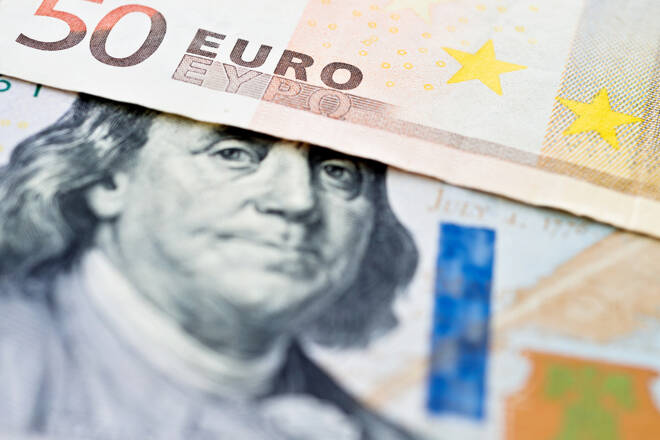Advertisement
Advertisement
EUR/USD Weekly Forecast: Services PMIs, Germany, the ECB, and the FED
By:
Service sector PMIs from the euro area and the US will give more clues about the respective economies, while central bank chatter will skew policy bets.
In this article:
Highlights
- The EUR/USD declined by 0.61% in the week ending February 2, closing the week at $1.07864.
- Service sector PMIs from the euro area and German economic indicators warrant investor attention in the week ahead.
- However, investors must also consider Fed and ECB speeches and economic indicators from the US.
Weekly Overview of the EUR/USD in the Week Ending February 2, 2024
In the week ending on February 2, the EUR/USD fell by 0.61% to $1.07864. The EUR/USD fell to a Friday low of $1.07798 before rising to a Friday high of $1.08975.
EUR/USD Analysis: Services PMIs and Germany in Focus
German trade data will draw investor interest early in the Monday session. A slide in exports and a narrower trade surplus could fuel expectations of a Q1 economic recession.
Economists forecast exports to fall by 2% and the trade surplus to narrow from €20.4 billion to €18.8 billion in December.
However, Services PMI numbers from Italy and finalized PMIs from France, Germany, and the Eurozone also need consideration.
The Eurozone services sector accounts for over 60% of the economy. An upward revision to the Eurozone PMI could ease fears of a Eurozone recession. However, investors must consider the sub-components, including prices. The services sector is the main contributor to inflation.
According to preliminary numbers, the Eurozone Services PMI slipped from 48.8 to 48.4 in January.
On Tuesday, German factory orders, Eurozone consumer inflation expectations, and retail sales will be in focus. Weaker-than-expected German factory orders and another fall in eurozone retail sales could support bets on an April ECB rate cut.
Economists forecast factory orders to stall in December and retail sales across the euro area to fall by 1.1%.
However, consumer inflation expectations could have more impact. Economists expect consumer inflation expectations to increase from 3.2% to 3.4% in December.
The German economy will be in focus over the rest of the week. Industrial production (Wed) and inflation (Fri) numbers warrant investor attention. A downward revision to preliminary inflation numbers and a fall in industrial production could support ECB discussions about rate cuts.
Economists forecast German industrial production to fall by 0.2% in December. According to preliminary numbers, the German annual inflation rate softened from 3.7% to 2.9% in January.
ECB Speakers
Beyond the numbers, investors must consider ECB chatter. ECB Chief Economist Philip Lane (Thurs) and Executive Board members Frank Elderson (Thurs) and Piero Cipollone (Fri) are on the calendar to speak.
US Dollar Update: Services Sector and the Labor Market
On Monday, the ISM Non-Manufacturing PMI warrants investor attention. A pickup in service sector activity could further impact investor bets on a March Fed rate cut. However, investors must consider the sub-components, including prices and employment.
Economists forecast the ISM Non-Manufacturing PMI to increase from 50.6 to 52.0 in January.
On Tuesday, RCM/TIPP Economic Optimism Index numbers will draw investor interest. Recent economic indicators, including the US Jobs Report, signaled a robust US economy. A larger-than-expected increase could further impact bets on a March Fed rate cut.
Economists forecast the RCM/TIPP Economic Optimism Index to increase from 44.7 to 45.2 in February.
US labor market economic indicators will garner investor interest on Thursday. A larger-than-expected fall in jobless claims would align with the Jobs Report for January and highlight a resilient US labor market.
Economists forecast initial jobless claims to fall from 224k to 220k in the week ending February 3.
Fed Speakers
Beyond the numbers, investors must also track FOMC member speakers. FOMC members Barkin (Wed/Thurs), Bostic (Mon), Bowman (Wed), and Mester (Tues) are on the calendar to speak. Discussions about the economic outlook, inflation, and the Fed rate path could move the dial.
Short-Term Forecast:
The near-term trends for EUR/USD hinge on services PMIs, economic indicators from Germany, and central bank chatter. Recent economic indicators support a more hawkish Fed stance versus a more dovish ECB, tilting monetary policy toward the US dollar.
EUR/USD Price Action
Daily Chart
The EUR/USD sat below the 50-day and 200-day EMAs, sending bearish price signals.
A EUR/USD breakout from the 200-day EMA would support a move to the 50-day EMA. A break above the 50-day EMA would give the bulls a run at the $1.09294 resistance level.
Services PMIs, the German economy, and central bank speeches need consideration.
However, a break below the $1.07838 support level would bring the $1.06342 support level into play.
The 14-period Daily RSI at 38.32 suggests a EUR/USD break below the $1.07838 support level before entering oversold territory.
4-Hour Chart
The EUR/USD hovered below the 50-day and 200-day EMAs, reaffirming bearish price signals.
A EUR/USD return to the $1.08 handle would support a move to the 50-day EMA. A break above the 50-day EMA would give the bulls a run at the 200-day EMA and $1.09294 resistance level.
However, a fall through the $1.07838 support level would bring the $1.06342 support level into play.
The 14-period 4-Hourly RSI at 38.87 indicates a EUR/USD fall below the $1.07 handle before entering oversold territory.
About the Author
Bob Masonauthor
With over 20 years of experience in the finance industry, Bob has been managing regional teams across Europe and Asia and focusing on analytics across both corporate and financial institutions. Currently he is covering developments relating to the financial markets, including currencies, commodities, alternative asset classes, and global equities.
Latest news and analysis
Advertisement
